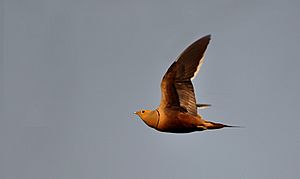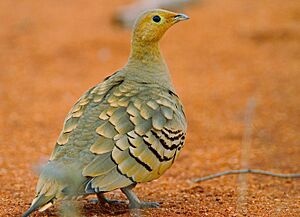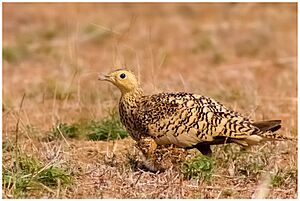Chestnut-bellied sandgrouse facts for kids
Quick facts for kids Chestnut-bellied sandgrouse |
|
|---|---|
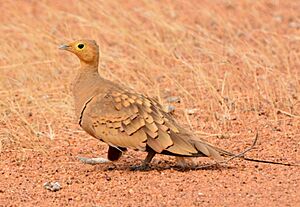 |
|
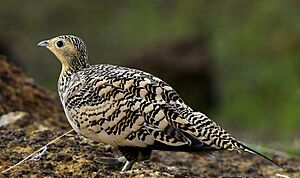 |
|
| male and female | |
| Conservation status | |
| Scientific classification | |
| Genus: |
Pterocles
|
| Species: |
exustus
|
The chestnut-bellied sandgrouse (Pterocles exustus) is a special type of bird called a sandgrouse. You might also hear it called the common sandgrouse. These birds don't usually migrate far. They live in northern and central Africa, and also further east in western and southern Asia. There are six different kinds, or subspecies, of this bird.
Chestnut-bellied sandgrouse look different depending on if they are male or female. Their feather colors also change a bit between the different subspecies.
These birds live in dry, desert-like areas. Even though they live in hot places, they need a lot of water. They are known to fly up to 50 kilometers (about 31 miles) in a single day just to find water!
Sandgrouse are picky eaters. They mostly eat seeds, especially small ones. They like to eat many small seeds at once.
Contents
About the Chestnut-bellied Sandgrouse
What Kind of Bird is It?
The chestnut-bellied sandgrouse belongs to a group of birds called Pterocles. All sandgrouse are part of the family Pteroclididae. This family is in an order called Pteroclidiformes. This means sandgrouse are actually more closely related to pigeons and doves. They are not a type of grouse, even though their name sounds similar.
Different Types of Chestnut-bellied Sandgrouse
There are six recognized types, or subspecies, of the chestnut-bellied sandgrouse:
- P. ex. exustus: Found in Senegal, Gambia, Mauritania, and Sudan.
- P. e. floweri: This type lives only in the Nile Valley of Egypt. People thought it was extinct, but it was found again in 2012!
- P. e. ellioti: Lives in southeastern Sudan, eastern Eritrea, northern Ethiopia, and Somalia.
- P. e. olivascens: Found in southeastern South Sudan, southwestern Ethiopia, Kenya, and Northern Tanzania.
- P. e. erlangeri: Lives in southwestern Saudi Arabia, Yemen, and Oman.
- P. e. hindustan: Found in southeastern Iran, Pakistan, and India.
What Do They Look Like?
Chestnut-bellied sandgrouse are small to medium-sized birds. They are brownish and have a long, pointed tail when they fly. When they are on the ground, they look like they have very short legs and a small head. If they feel worried, they will stretch out their long necks.
The color of their feathers can be different among the six subspecies. For example, the type found in the Nile Valley (P. e. floweri) has darker, grayer feathers on its head and chest. It has less yellow on its wings compared to the Pterocles exustus exustus type from Senegal.
Some types, like P. e. ellioti and P. e. erlangeri, are lighter and grayer. The P. e. olivascens type has a distinct grayish-olive color on its upper body and wings. Female birds of this type have more stripes and bars on their undersides.
Male and female chestnut-bellied sandgrouse have different feather colors. This is called sexual dimorphism. For example, in the Thar Desert of India, males have brownish-gray upper parts. Their faces and throats are a dull yellow, sometimes with orange. Their upper chest is a reddish-brown, with a thin black band bordered by white. Their lower chest turns into a chocolate color, with a black center on their belly.
Female sandgrouse have duller upper feathers with dark brown streaks and blotches. Their neck, chest, and sides of the head are reddish-brown with black spots. Their lower chest is a pale yellow-brown, and their belly has many dark brown bars.
The P. e. floweri subspecies in the Nile Valley also shows clear differences between males and females. Males often have an orange tone around their necks and faces. They have sharp black lines across their pale upper chest. Females have more mottled brown and white on their chest and neck, and they don't have the black lines that males do.
Where Do They Live?
The chestnut-bellied sandgrouse lives across most of northern and central Africa. They also live further east in western and southern Asia. These birds are found in many places, mostly in the Afrotropic and Indomalayan regions. They like to live in bare, dry, and sandy plains with some bushes.
In India, you can find many chestnut-bellied sandgrouse in the Thar or Sindh Deserts. During the hot summer, when water is hard to find, thousands of these birds might gather at one waterhole to drink. When it rains and there's more water, they tend to travel in smaller groups.
The floweri subspecies in Egypt was first found in the mid-1800s. It lives only in the Nile Valley. By the late 1800s, it was the most common sandgrouse in Egypt. But by 1929, they became rare. The last time this subspecies was seen was in 1979, until it was rediscovered by scientists in 2012!
How Do They Behave?
The chestnut-bellied sandgrouse usually stays in one area. This is different from most sandgrouse, which are migratory (meaning they travel long distances). However, these birds do move around a lot locally. In summer, if water is scarce, they will move to nearby areas where water is still available. They also seem to move long distances sometimes, depending on where they can find food.
What Do They Eat?
Like all sandgrouse, the chestnut-bellied sandgrouse eats small seeds, tiny insects, and fallen berries. Their main food is small seeds, especially from leguminous plants (like beans or peas). They eat a lot of these seeds.
Even though they live in dry places, these birds drink water regularly every day. They gather around water sources. They usually prefer to drink once a day at sunrise. Sometimes, they might drink a second time before sunset, but this is less common.
How Do They Raise Their Young?
Chestnut-bellied sandgrouse can start having babies after they are one year old. We don't know how long they live in the wild. But in captivity, some adults have lived for up to 3 years.
During the breeding season, male birds have bright, new feathers and long central tail feathers. Males will chase females and make soft sounds to attract them. Often, several males will try to court one female, but only one male will follow her closely.
Females lay about three to six eggs. They make their nests in shallow scrapes on the ground. In places like the Thar and Sindh deserts, they also make shallow nests on the ground, usually with three eggs. These nests are often out in the open and not hidden.
The eggs are usually pale gray or yellowish, with small brown spots and blotches. They are about 3.68 cm by 2.62 cm (about 1.45 by 1.03 inches) in size. In captivity, the female bird usually sits on the eggs to keep them warm. All the young birds hatch at the same time. In the wild, males have been seen incubating eggs at night.
Once they hatch, the chicks stay near the nest for a day or two. In the Thar and Sindh deserts, the chicks are very active right after hatching. They can leave the nest soon after they are born.
Who Are Their Enemies?
The chestnut-bellied sandgrouse seems to be very strong against diseases. They don't easily get common bird sicknesses like Newcastle disease. They are also quite resistant to diseases that affect chickens. While they can get parasites like pinworms, it's very rare.
Falcons are known to hunt chestnut-bellied sandgrouse, especially when the sandgrouse gather at waterholes in India.
Sandgrouse and Humans
Hunting and Introduction to New Places
This bird species was brought to Hawaii by the Nevada state game department. They wanted to see if the birds would be good for hunting in Nevada. So, between 1961 and 1962, they released these birds on the Hawaiian islands of Hawaii, Molokai, and Kauai.
They also released the birds in Japan, in places like Pahranagat Valley, Pahrump Valley, and Moapa Valley. The birds released in Pahranagat Valley in 1960 left right away, and no more were released there. In Pahrump and Moapa Valleys, some birds stayed for a while in the summer and fall, but they all left during the winter.
Some sandgrouse that were released in Pahrump Valley were later found far away in Mexico. This suggests that these birds might have flown south into desert areas from where they were first released.
Keeping Them in Zoos or Homes
Even though these birds are attractive, they are rarely kept in captivity. This might be because they are very nervous and hard to get used to being in cages. A study in 2008 found that many captive sandgrouse died from stress. They would fly into the wire mesh of their enclosures and get hurt. Young chicks sometimes died from not eating enough. This shows that stress is a big problem for these birds in captivity.
Attempts to breed these birds in captivity in Utah between 1959 and 1961 were not very successful. By the end of 1962, only one egg was laid.
External sources
- Saint Louis Zoo



